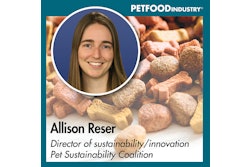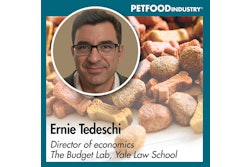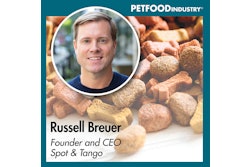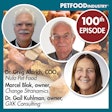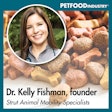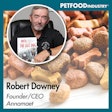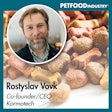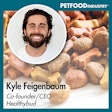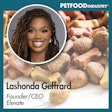
In the latest Trending: Pet Food podcast, host Lindsay Beaton sits down with NutriFusion co-founder and CEO William Grand to define the benefits of synthetic versus non-synthetic nutraceuticals, examine the trend around meaningful health benefits, and explore where the future of nutraceuticals in the pet space is going.
Transcript
The transcript below is from Episode 85 of the Trending: Pet Food podcast, where host Lindsay Beaton and William Grand, co-founder and CEO of NutriFusion examine nutraceuticals and their growing role in pet food. You can find the episode at Trending: Pet Food Podcast, on SoundCloud or on your favorite podcast platform. This episode originally aired on April 23, 2025.
We want to thank Coperion for sponsoring this podcast. Coperion brings together some of the world's most trusted technology brands to offer innovative system and ingredient automation solutions to pet food producers worldwide.
Lindsay Beaton, editor, Petfood Industry magazine and host, Trending: Pet Food podcast: Hello, and welcome to Trending: Pet Food, the industry podcast where we cover all the latest hot topics and trends in pet food. I’m your host and editor of Petfood Industry magazine Lindsay Beaton, and I’m here today with William Grand, co-founder and CEO of NutriFusion. Hi William, and welcome.
William Grand, co-founder and CEO of NutriFusion: Good morning.
Beaton: In case you’re unfamiliar with William or NutriFusion, here’s what you need to know.
With over 35 years of experience in corporate management, sales and marketing, William exercises his expertise in food retail, distribution, product development, logistics and administration to head up NutriFusion, drawing on previous roles that involved supporting international product launches and start-ups, overseeing international logistics and fulfillment centers, and supporting and hiring local managers, leaders, and distributors. He has worked closely with companies from Asia, Europe, and Canada. William previously held the role of CEO for Earth Eco Research LLC and was President at Mackay Specialties. He attended Carleton University (HBA, Law, Psychology) and Upper Canada College.
Founded in 2008, NutriFusion provides the nutrient-rich benefits of fruits and vegetables in everyday food products through whole non-GMO foods to create its concentrated micronutrient and phytonutrient-rich food ingredient blends. GrandFusion, the company’s blends of nutrients and vitamins, can significantly increase the nutritional profile and marketability of food, beverage, pet and supplement products. Blend customization is also offered to capture specific vitamins, minerals, fruits and vegetables. Above all, NutriFusion uses only fresh food, no synthetic additives or ingredients, excipients or preservatives.
William’s business acumen and particular expertise in nutraceuticals are why I’ve brought him on today to answer this question: What roles do nutraceuticals play in pet food?
So William, with a topic as specific as this, I always like to start with a bit of a 101 question that lets us define what we're going to be talking about. Broadly, what is the definition of nutraceutical and how do nutraceuticals serve a purpose in pet food?
Grand: Nutraceuticals for pets are essentially defined more as a dietary supplement that is intended to improve the animal's health and welfare.
Beaton: Is it something that has always been included in formulations, or at some point, did people begin using them to replace something else or to enhance something? Are they considered more functional or essential?
Grand: It is an add-in to try to improve the nutritional value of pet foods. Where it has its value is, due to processing and the products that go into some of the pet foods, the nutritional value of the pet food itself can be anywhere from zero or almost zero to having some nutritional value. It was originally started to supplement pet food with going back in time -- and even now -- synthetic vitamins.
Beaton: I'm glad you mentioned synthetic, because to have this conversation, we also need to baseline the differences between nutraceuticals and synthetic options. What are the differences and benefits and challenges of both?
Grand: Synthetics are found in nutraceuticals. What is new is that we can now deliver plant-based nutrition with all the benefits of plant-based nutrition as an alternative to synthetic vitamins going into pet food.
Beaton: What are the reasons why someone might choose to use a synthetic versus a natural or the other way around. Is it strictly a price thing? Is it a bioavailability thing? How do they bump up against each other?
Grand: Great question. Plant based is more expensive. Synthetics are man-made chemicals. That's the big difference. In terms of performance, plant-based nutrition performs very well, and it is bioactive and bio absorbable, so it does what it's supposed to do, whereas synthetics -- without being too blunt -- synthetics don't work. They only provide a tiny amount of true nutritional value, and that can be anywhere from a little over 0% to 5% to the absolute maximum for a vitamin, maybe 10%.
Whereas the nutritional value of plant-based nutrients can be as much as the body needs, depending upon the amount of nutrients that you're adding into it from plants.
Beaton: Why were synthetics created to begin with? Are there nutrients that just aren't found in all the ingredients being used in pet food? Or do some of the nutrients get destroyed during the extrusion process or the kill step that mandated extra nutrients on top of that? How did that even become a thing?
Grand: If you have a -- and I'm going to use food rather than pet for this example -- it could be a little less upsetting for some people. Synthetics are used because there's no other alternative. That also applies for pet people want it to be able to enhance or show that there is an actual value to what they're selling.
Typically, with modern processing, especially if you're looking at the human side, modern processing destroys all the nutrients that are in any product. You end up with high amounts of sugar and salt and all sorts of unhealthy ingredients in a product. All the nutrition has been eliminated.
Synthetics were a way that they tried to, at least visually -- and I use that word very carefully -- visually make it look like there's nutrition in it. The bio absorbability of synthetic vitamins, however, is minimal, absolutely minimal. People say, “Oh, look, I've got all these vitamins.” But if you look at them in terms of what's being offered, they may be showing up, but it's synthetics which does not have the bioavailability and the bio absorption of plant-based nutrition.
I can give you a good example. I was at a dinner party four or five years ago. As soon as people hear you're involved in nutrition, people get very interested and the conversation sidetracks. The host said, “I have no problem. I get my servings of fruits and vegetables every day.” I said, “Okay, how do you do that?” He said, “I drink V8 fusion tomato juice.” I said, “Do you happen to have a bottle with you?” He goes into the fridge, brings it out, and it was zero nutritional value. There was no real vitamin A, C, D, E, any of the Bs or K. Absolutely zero in this case, on everything.
So, a company would have a choice there of adding synthetics, making it look good, or just leaving it all out. This company, which is Campbell's, has done it either way. When I took the bottle, turned the label over, and had him look at the ingredients and the nutritional label, everything was zeroed out. Then, surprise, surprise, salt was like 45% per glass -- something this individual should not have been drinking at all. His comment was, “Don't tell me that! That's the only way that I've been getting my nutrients.”
It's a very, very good example of clever marketing by food, pet, beverage supplements, making claims that they have vitamin A, C, D and so on, but what they don't say is the bio absorption of it is minimal or absolutely down to zero.
I digressed a bit, but it gives you a good example of what the consumer has never been properly taught or explained, which is what we're talking about right now.
Beaton: When you co-founded NutriFusion, and you were talking with your business partners and having these conversations about what need NutriFusion could fill, what the potential was for it in the pet food space. What did those conversations look like? Was it something that the industry was already asking for? Was it a hole that you felt needed to be filled, then the customers came after everything was established?
Grand: That's an excellent question. I got interested in this product, and it was in development, in the works. The way it evolved was when we finally got to a point where we knew we had a product where we could provide plant-based nutrition into a wide range of food, pet, beverage and supplements, and so on. At that point, we figured, okay, we had a product that would work, and now we must make people aware of it.
We simultaneously went to food retailers and food processors, and said, “Hey, we're NutriFusion. Here's what we can do. Here's some of the benefits, which, it's a very long list of benefits.” It took us about two years before we started getting traction on the company. A little over two years. Then suddenly, we picked up two significant accounts, and the company moved forward from there.
It was almost a chicken-and-egg scenario, where the food retailers would say, “I like this, but nobody's ever offered it to us.” You go to the food processors, and they would say, “I like this, but no retailers ever asked for it.”
The challenge was for us to eventually get enough interest so that both sides would come onboard and look at it seriously.
Beaton: Now that you're more established, what are you seeing right in terms of demand for nutraceuticals overall, and for non-synthetic ones in particular? Is there a specific segment of pet that comes to you as a client? Or is everyone exploring their options when it comes to this kind of thing?
Grand: When we introduced it into the pet market five, six years ago, it was very, very well received. I’m going to give you a side story again that's quite a compliment to the pet industry. People would look at the product, and they would come back to us and say, “This is a game changer.” Because it did what we said it would do. There is no smoke and mirrors. There is no “put these synthetics in which don't work.” We created an opportunity for the pet industry.
My compliment to the pet industry is they were very, very interested in the product. They felt that everything for them was about the health and welfare of the animal. They really are very, very focused on that, which was a surprise for us. We’d been working in the food and beverage category, and in that category, it was all about market share sales. If cardboard had vitamins in it, they'd sell cardboard. It was that kind of mentality. Not all of them, but the vast majority. Whereas, the pet space was more, “Gee, this really has an application, because it's going to be very good for the health of dogs and cats.” We got a very strong response because of the nature of what the product could do.
Beaton: When people come to you with the need for this thing, do you need to look at their formulation? Do you find that there are adjustments to be made when they're going from synthetic to non-synthetic nutraceuticals? Does it depend on how you're processing the food? What are some of the technicalities of shifting your formulation from synthetic to non-synthetic? How easy or challenging is it?
Grand: What we produce is a powder. The powder can have X amount of ingredients -- six ingredients, six nutrients, 12 nutrients. We have a 21-nutrient blend, which is a combination of nutrition, vitamins and minerals. We start working with customers on what they're after, what they want to achieve.
One thing that might be a bit of a surprise is you don’t need as much on a percentage basis as you do on the synthetic side. The reason for that is when people are buying synthetic foods and or pet foods, they spike it. They may put in 1,000% of vitamin C, for example. You can find that on retail shelves. Now, your body can only absorb 100%, but they figure that it’s going to make it look better, even though it doesn't get absorbed properly.
With us, we try to focus on the percentage. We can put in up to 100%. We generally recommend saving some money and reducing the amount to maybe 25%-50% of our blend of 12 vitamins. The advantage of that is, because it's so bio absorbable, if we put in 1,000%, we're going to cause problems to the health of the people. If we put in 50%, people are still going to be eating food and picking up some advantages. By putting it down to 25%-50%, whatever they want, we'll make recommendations on it, and they will have the product at a reasonable level.
The other advantage is, if you put in 100%, your body's probably going to pass some of that right out. It doesn't need that much, and the amount that you need will depend on the individual. If somebody is a health fanatic and they're eating lots of fruits and vegetables, and they're quite healthy, they may require a minimal amount from us. If there's somebody that hates fruits and vegetables and does not want to eat them and won't eat them at that point, we can provide nutrition. They can take the product and get the anti-inflammatory advantages and the bio absorption into the body.
There are two terms, and I won't get into them right now, but one is called oxidative stress, which is a good term for anybody that's listening to Google. The other is free radicals. Essentially, free radicals are created by our poor diets. The free radicals are what helps to promote chronic disease. I'll leave it at that, because it gets very complicated for a few minutes.
Beaton: Do you find that there are segments of the industry coming to you. Is it the super-premium space? Is it mostly food? Are there treats involved? Is the supplement space coming to you to help buff up their formulations? Who are you seeing come to you most and be most interested in a non-synthetic option?
Grand: The answer to all those options is “all the above” for the pet industry. They have a great interest in the health and welfare of the animals. On the supplement side, the product will work and perform. We are more expensive. Synthetics are cheap to produce. They look good on the label with our product, we deliver as stated, and we tend to under-promise. We don't want to over-promise and cause any issues. We're happier understating the advantages and let them do their own work and R&D and product development, then start to have their product analyzed and see where the results land.
Beaton: You've mentioned a few times that it's more expensive. When you're couching the price to people and you're explaining it to them, versus synthetic pricing, Is it more of an upfront cost for a longer-term nutritional benefit? Is it lower inclusion rate because of higher efficacy where the cost evens out at the end? What is that price conversation like? I feel like that would be the biggest barrier, if anything, versus synthetic options.
Grand: People will buy our product for a variety of reasons. One is we give them a squeaky-clean label. There are no chemicals or anything listed in it. For example, our list would consist of broccoli, spinach, blueberries, raspberries, apples, and that's all that needs to go on the label. It's very clean. There are no six syllable words to pronounce that nobody can pronounce anyways. It’s clean, it's easy, and it enhances their product.
There was a huge shift, especially prior to COVID, but it really took off in COVID, where everybody is interested in better-for-you products. The companies that we work well with are the ones that are looking for better, healthier products, whether it's many of the categories that we've keep talking about.
Beaton: That’s such a significant conversation in the pet space. You're right, it got a huge boost during COVID. Everybody was suddenly paying more attention to their own health and that extended to their pets. Now, suddenly, health and wellness are a huge, huge conversation -- way bigger than it's ever been before.
Is that something that people have been coming to you as a primary factor in their formulations and why they want to switch from synthetic to non-synthetic? Or even just when they're making a new formulation and they want to go non-synthetic from the start? Or is it just something they're kind of using as a “Oh, and also, we can do all of this”?
Grand: Again, the answer is generally “all of the above,” but probably the weakest is “oh, by the way, we can do this.” They would develop a product, and then once the product is developed and they finished off their R&D, testing, packaging and taking it to market, that's when things can get quite interesting.
To give you an example, we have one account that started two-and-a-half, three years after we started the company, and they started buying a little bit of powder for testing. I should point out, we're extremely concentrated -- 225 milligrams will give 50% of the daily value. To understand that amount, hold up and squeeze the very end of your baby finger, that’s about what's going in for a serving.
By adding less or more, we can increase the amount of plant-based nutrition that's going into the product. It’s very easy to use, but it's highly concentrated.
Our product does not impact taste, flavor palette, feel or texture. Because there's such a small amount, because of concentration, it disappears. Dogs would have no idea that it's in there, that they're getting this nutrition. Humans don't. But where it shows up is on the packaging, the label, the front panel, which is where all the marketing is, and on the back, you've got the nutritional label and the ingredient deck. Those are the two things that make our products stand out, because they’re so clean.
Beaton: We've talked a lot about the history and the current state of nutraceuticals. As we wrap things up, I want to talk about the future, because of what we've been talking about, because health and wellness is such a significant topic now, and anything that rotates around that is a significant trend right now. What do you think is the future of nutraceuticals in the pet space?
Grand: It'll get stronger and stronger. There's no question. When we sell our product, for example, into manufacturers of dry dog food, they put a very, very small percent of our product into it. Typically, less than 1% would represent us, maybe 1/10 of 1%, 2/10 of 1% of the total serving size would be our ingredient.
It goes in, it disappears, it provides nutritional value. The label lists out the fruits and vegetables that are used in it. With the pet industry, we typically use a pet blend designed specifically for pets, especially dogs, that covers 20 to 21 nutrients, including many minerals such as iron and potassium and more.
Beaton: I want to thank you for coming on today, William, because pet food formulation is obviously a specific interest to my audience. Diving into a particular component of that always makes for a great conversation. Also, I've heard a lot of conversations, especially over the last several years, in synthetic versus non-synthetic everything. So, any kind of ingredient that can be made synthetic versus a more natural option, is really a conversation to be had in the pet space, and especially with pet owners wanting clean label, wanting ingredients they can understand. The way that we have historically created food, versus some of the trends going on now, and even right up to the price point that we were talking about earlier, all of these are very pertinent to what's going on right now. So, thank you so much for coming on and diving into it with me.
Grand: My pleasure. I enjoyed it, so thank you. You ask great questions.
Beaton: Oh, thank you. Before we go, I always like to do a little plug for my guests. So where can people find more information about you and NutriFusion?
Grand: I am on LinkedIn, and our website is NutriFusion.com.
It’s very information-intense, so if somebody has an interest, they can really delve into it. There's a section for humans and a section for pets on the landing page.
The other thing I should mention is across the top is a menu. There's a section called active research, and we have been working with a research scientist who's at University of South Florida. He has done some amazing research, mostly with mice that are bred to have strokes within six to nine months. What they found is that using our ingredient delays the onset of the stroke and dramatically reduces the amount of damage caused by the stroke. There's another one which covers stamina and energy. Again, they've been using mice. The NutriFusion group is using a roto wheel and a maze with aged mice. The aged mice perform significantly better with our product over the control group, and they were able to run the maze with far more accuracy. They are also able to do gross motor coordination with the roto wheel and last longer and perform better on that as well.
As a sidebar, a couple months back, we finished our first human study, and while the results aren't available yet, preliminaries are really, really encouraging,
Beaton: That’s it for this episode of Trending: Pet Food. You can find us on PetfoodIndustry.com, SoundCloud or your favorite podcast platform. You can also follow us on Instagram, @trendingpetfoodpodcast. And if you want to chat or have any feedback, I'd love to hear from you. Feel free to drop me an email: [email protected].
Of course, thanks again to our sponsor, Coperion. Coperion brings together some of the world's most trusted technology brands to offer innovative system and ingredient automation solutions to pet food producers worldwide.
Once again, I'm Lindsay Beaton, your host and editor of Petfood Industry magazine, and we'll talk to you next time. Thanks for tuning in!


